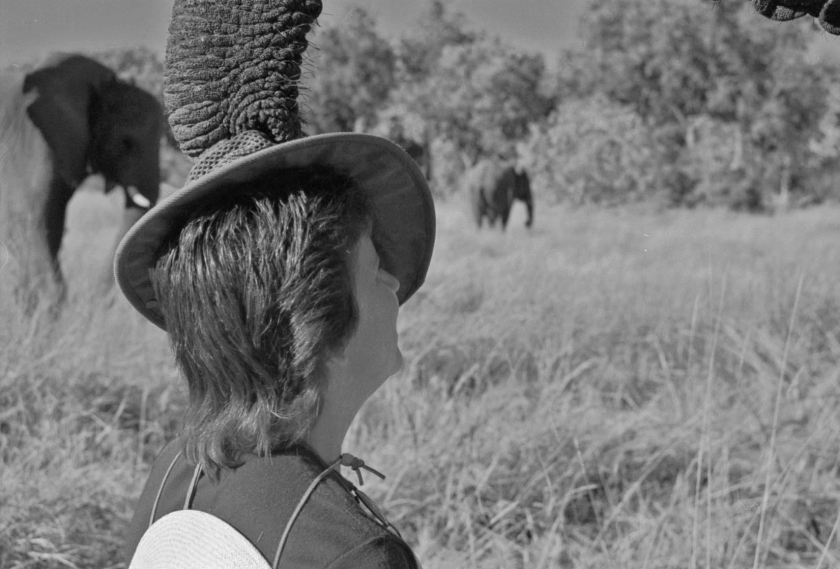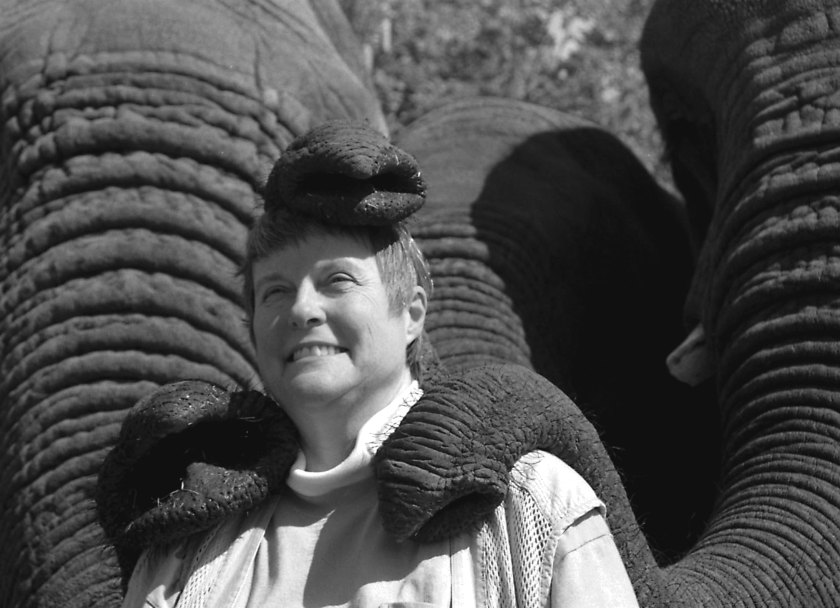An excerpt from my book, Larger than Life:
Doug gets my full attention when he proclaims to his guests, “Thembi has a great set of knockers.”
“Thembi, leg.”
She obliges by bending her left front leg at the knee and raising it, exposing a clear view of her breast. “See? Elephant mammary glands are located on the chest, like humans.”

I lean over Doug’s shoulder and look at two gray breasts with permanently erect nipples. They’re about the size of a medium cantaloupe and, like human breasts, slightly globular, due to the pull of gravity.
“Alllllll-right, Thembi.” As her foot touches the ground, she flaps her ears and her trunk snorfles around his feet.
“If you reach in like this,” Doug demonstrates, “you can feel them.”
Steadying myself with one hand on Thembi’s leg, I reach in and cup her breast with the other hand. The skin of her breast is as soft as an old, creased leather bag. Her nipple, as one might expect, is harder than the flesh around it.
Thembi emits a low, murmuring rumble.
“Oh you like that, do you, Thembi girl?” Doug chuckles.
I quickly withdraw my hand and step away from her side.
“Anyone else want to try?” asks Doug.
Out of the seven of us, several people look away, several look down. No one ventures forward. I can’t tell if everyone is embarrassed or just reticent. Feeling up an elephant may not be quite what they had in mind. It certainly wasn’t what I had in mind.
“Well, OK. Mammals are called mammals because . . . . ?”
One of the guests ventures, “Mammary glands?”
“Right.” Doug continues his lecture: “Like all mammals, Thembi’s lactiferous ducts terminate in her nipples. They point out a bit, while Morula’s nipples point down. Thembi gets a bit of stimulation while she walks, don’t you, Thembi girl?”
Some of the guests look mildly scandalized, while others giggle and whisper to each other.
Doug rubs Thembi’s leg, which generates another snorfle.
Female elephants don’t have a row of teats, like cats or dogs. They don’t lie on their sides, suckling a litter. Elephant calves nurse standing up, with their small trunks flipped over an eye like a wayward curl.
All mammal breasts are modified sweat glands. Some mammal breasts are located in the groin and some on the chest. The breasts between Thembi’s front legs are in the same location mine would be if I walked around on all fours. Her breasts weigh about four pounds each, .1% of her body weight. Human breasts weigh .08% of total body weight, dogs 2%, rats 9%.
Do all mammals have larger breast size to body weight than humans? I pull out my notebook to write down that question, but then decided I really don’t care, and put the notebook away.
“Is she pregnant?” asks the woman behind me.
Although Thembi possesses relatively trim tonnage in comparison to the other two elephants, she is significantly rounder – huge thighs, huge belly, a Rubenesque sort of girl with a really long nose – and very full breasts, unusually large for a non-pregnant elephant.
“We don’t think so,” Doug replies. “We had her hormone levels tested about six months ago, and they were normal. She’s an enthusiastic eater, so she might be a tad rotund because of that. She might be incubating a surprise, but we doubt it.”
Sandi laughs. “That’s because she’s a bit of a flirt with the wild boys around here, but when things get serious she becomes quite horrified and scoots on home.”
Another one of the guests pipes up: “Has Jabu ever tried mating with her?”
“Yes, he’s tried,” Sandi replies, “But we’ve never yet seen him achieve intromission.”
Heads nod thoughtfully. I can see intromission has thrown them a bit. It’s not a word commonly used to describe sexual penetration, but I think most of the guests have a general idea of what it might mean. Several of their heads swivel to gaze at Jabu, ripping apart a nearby bush. Since he’s such a big boy, why couldn’t he just have his own way?
“Thembi doesn’t really favor him,” says Sandi, as if she’s reading minds.
“What if she had a calf?”
There’s not one second of hesitancy to Sandi’s reply: “Oh, we’d keep it. It wouldn’t be easy, though. Thembi’s never been in a breeding herd and has no clue about birth. And she’s rather stuck on herself, you know. We don’t think she’d be a good mother. But if it happened, we’d make it work.”
Even though it’s not likely that Jabu and Thembi will become pachyderm parents, I can easily imagine Thembi as a pregnant princess, mood swings, food cravings and all. As if to prove my point, she regally sweeps through a stand of grass, a princess on a mission. She breaks off a few branches from a small thornbush, stuffs them against her back molars and chews with her mouth open.
Thembi has never been with an extended herd of mothers and sisters and aunts and hasn’t had the opportunity to learn the complex behaviors required to be a mother. She’s never learned that newborn calves stay in physical contact ninety-nine percent of the time, either below or beside their mothers. Although calves will begin to forage by nine months, they continue to suckle for about four years. Elephants in zoos will quite frequently shun newborn calves. So I can just about predict Thembi’s reaction to a calf: What IS this thing following me around?
I glance over at Jabu. He has nipples, too. Guy nipples, nozzle-like nipples, surrounded with sparse hair.

All mammals have three distinct features: hair, three middle ear bones, and mammary glands. Even whales, dolphins, porpoises and manatees have hair, usually on their snouts or next to blowholes. Elephants and manatees shared a common ancestor fifty-six million years ago, but the nipples of female manatees are now under their flippers, in their armpits.
A question comes from the back of the tourist group. “What about Morula?”
Dear, Old Maid Morula. The wallflower with big ears, large liquid eyes and a knobby forehead.
“If an elephant doesn’t breed by the age of twenty-five, they are unlikely to,” Sandi replies. “Morula is already the ripe old age of thirty.”
Female elephants typically become active at a quite young age, around thirteen. They can conceive as early as ten years old and possibly have 12-15 offspring by the time they are fifty. Female calves will stay with the herd the rest of their lives.
Male elephants take a bit longer to mature and become sexually active around the age of twenty-nine.
Morula has missed the boat. But I’ll bet she’d make a great aunty. She stands close by, slowly opening and closing her great ears, patiently watching.

When he first developed his classification system, Swedish botanist and zoologist Carl Linnaeus originally called mammals Quadrupedia, after the name Aristotle gave them. Later he became actively opposed to wet-nursing practices in the 1750s and wrote a book on the benefits of breast-feeding your own child. As a political act, he reclassified Quadrupedia to Mammalia in later editions of his most famous work, Systema Naturae, defining mammals as a lactating class within the Animalia kingdom, a classification that has lasted to this day – all because women of nobility in Linnaeus’s time thought breastfeeding would ruin their figures.
Certainly that’s one thing Thembi doesn’t have to worry about.



















